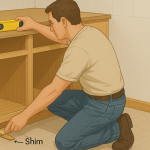Shims are small but essential tools that make big projects possible. Whether you’re hanging cabinets, leveling doors, or aligning machinery, shims provide the precision that separates a clean installation from a crooked one.
At their core, shims are thin, wedge-shaped or flat pieces used to fill gaps, level surfaces, plumb objects, or align components. They deliver fine adjustments where measurements fall short or materials shift, saving time and preventing rework.

What Are Shims Used For?
Shims solve one simple problem: unevenness. They compensate for irregular surfaces, structural settling, and imperfect materials. Common applications include:
- Cabinet Installation: Leveling base cabinets on uneven floors before fastening.
- Door Hanging: Ensuring even spacing around the jamb for smooth swing and closure.
- Flooring and Trim: Aligning moldings and baseboards against walls and floors.
- Appliance Installation: Leveling washers, dryers, and dishwashers to prevent vibration.
- Furniture Repair: Stabilizing wobbly tables or shelving units.
- Machinery Setup: Aligning equipment in manufacturing environments for accurate operation.
In short, anywhere there’s a gap, slope, or misalignment, a shim brings things back to level.

Types of Shims
Shims come in different materials and designs depending on the application. The right choice ensures stability and durability.
| Type | Best Use | Key Benefits |
|---|---|---|
| Wood Shims | Framing, doors, and light carpentry | Easy to cut, shape, and tap into place |
| Composite Shims | Kitchens, bathrooms, and damp environments | Moisture-resistant and rot-proof |
| Plastic Shims | Heavy-duty installations and outdoor use | Won’t compress or degrade over time |
| Metal Shims | Machinery and precision equipment | High strength, exact thickness options |
| Stackable / Adjustable Shims | Repeated or adjustable setups | Quick, tool-free leveling |
For most home and cabinet installations, composite and hardwood shims strike the best balance of strength, stability, and workability.

How to Use Shims
Using shims is simple once you know where to start.
- Identify the Low or Uneven Spot: Use a level or straightedge to find where gaps appear.
- Insert the Shim: Slide or tap the shim into place until the surface is level or plumb.
- Secure the Position: Once aligned, trim any excess and fasten your materials together.
- Double-Check Level: Always recheck after fastening—tightening screws can shift alignment slightly.
Pro Tip: Work in pairs—place one shim in front and another behind the object for even support.
Common Shim Materials and When to Use Them
- Wood: Ideal for quick carpentry fixes. Avoid in damp or outdoor conditions.
- Composite: Perfect for kitchens, bathrooms, and under-sink applications. Won’t swell or rot.
- Plastic: Great for heavy loads and long-term outdoor use.
- Metal: For precise industrial alignment or machinery setup.
For most woodworking or cabinetry tasks, composite shims provide reliable, moisture-resistant performance.

Why Shims Matter
Skipping shims can lead to uneven doors, cracked countertops, noisy appliances, and gaps that ruin a clean install. Proper shimming:
- Keeps doors and drawers square
- Ensures appliances fit smoothly
- Prevents countertop lippage
- Reduces vibration and noise
- Extends the life of your installation
A few cents’ worth of shims can save hundreds in callbacks and rework.

Final Thoughts: What Are Shims?
Shims may be small, but their role in creating straight, stable, and long-lasting installations is huge. From framing to finishing, they make alignment easy and reliable.
For durable, contractor-grade options, shop composite, hardwood, and stackable shims at WoodworkerExpress.com. Keep a pack on hand—you’ll use them more often than you think.
Next Up > How to Shim Cabinets


